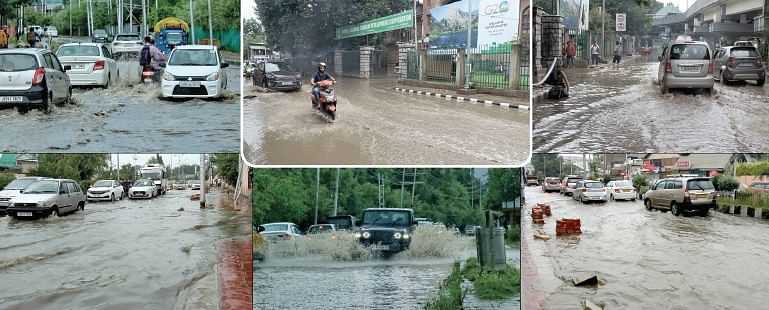
A brief yet intense spell of rain recently triggered severe waterlogging across many parts of Srinagar, causing major distress for residents and drawing public outrage over the city's failing drainage systems. Even a single hour of rainfall flooded lanes, homes, shops, and roads—paralyzing daily life in multiple neighborhoods including Old City areas like Khanyar, Rajouri Kadal, Nawakadal, Bohri Kadal, and uptown sectors like Bemina, Batamaloo, Soura, and HMT .
Residents reported floodwaters entering their ground floors within minutes, forcing families to relocate upstairs. “One hour of rain and we’re drowning,” said Farooq Ahmad from Aqilmir Khanyar. “We need a permanent drainage overhaul—not band-aid solutions”
Local traders in Lal Chowk and adjacent markets saw water flooding into their shops, stalling business and fueling frustration with authorities On the VVIP airport route, Humhama–Airport Road was submerged, dismantling commuter viability and embarrassing the city’s i
Critics argue that investments in “Smart City” projects have overlooked essential urban infrastructure like drainage. Despite the installation of 104 dewatering stations and mobile pumps, their performance is inconsistent due to power failures and lack of coverage in key areas . In places without permanent pumping stations—such as IG Road—mobile units now serve as band-aids until fixed infrastructure is installed
Calls for action are intensifying. Residents urge authorities to launch a one-time, citywide drainage renovation. They stress that localized upgrades won’t suffice without an integrated plan addressing all vulnerable zones Health concerns add urgency—stagnant water is breeding mosquitoes and increasing risk of waterborne diseases
Responding to the crisis, officials have deployed emergency teams with dewatering units and redirected pumping strategy to affected zones. Proposed long-term solutions include modernizing drainage systems, installing reliable pumps with backup power, and possibly redesigning old waterways—restoring natural basins and clearing urban choked drains .
Residents remain skeptical: "If this is a ‘Smart City,’ why do we sink after every shower?" With more rains expected this monsoon, many are demanding decisive action—drains cleaned, power backup for pumps secured, and holistic planning implemented—before the next deluge hits.
A brief yet intense spell of rain recently triggered severe waterlogging across many parts of Srinagar, causing major distress for residents and drawing public outrage over the city's failing drainage systems. Even a single hour of rainfall flooded lanes, homes, shops, and roads—paralyzing daily life in multiple neighborhoods including Old City areas like Khanyar, Rajouri Kadal, Nawakadal, Bohri Kadal, and uptown sectors like Bemina, Batamaloo, Soura, and HMT .
Residents reported floodwaters entering their ground floors within minutes, forcing families to relocate upstairs. “One hour of rain and we’re drowning,” said Farooq Ahmad from Aqilmir Khanyar. “We need a permanent drainage overhaul—not band-aid solutions”
Local traders in Lal Chowk and adjacent markets saw water flooding into their shops, stalling business and fueling frustration with authorities On the VVIP airport route, Humhama–Airport Road was submerged, dismantling commuter viability and embarrassing the city’s i
Critics argue that investments in “Smart City” projects have overlooked essential urban infrastructure like drainage. Despite the installation of 104 dewatering stations and mobile pumps, their performance is inconsistent due to power failures and lack of coverage in key areas . In places without permanent pumping stations—such as IG Road—mobile units now serve as band-aids until fixed infrastructure is installed
Calls for action are intensifying. Residents urge authorities to launch a one-time, citywide drainage renovation. They stress that localized upgrades won’t suffice without an integrated plan addressing all vulnerable zones Health concerns add urgency—stagnant water is breeding mosquitoes and increasing risk of waterborne diseases
Responding to the crisis, officials have deployed emergency teams with dewatering units and redirected pumping strategy to affected zones. Proposed long-term solutions include modernizing drainage systems, installing reliable pumps with backup power, and possibly redesigning old waterways—restoring natural basins and clearing urban choked drains .
Residents remain skeptical: "If this is a ‘Smart City,’ why do we sink after every shower?" With more rains expected this monsoon, many are demanding decisive action—drains cleaned, power backup for pumps secured, and holistic planning implemented—before the next deluge hits.
© Copyright 2023 brighterkashmir.com All Rights Reserved. Quantum Technologies